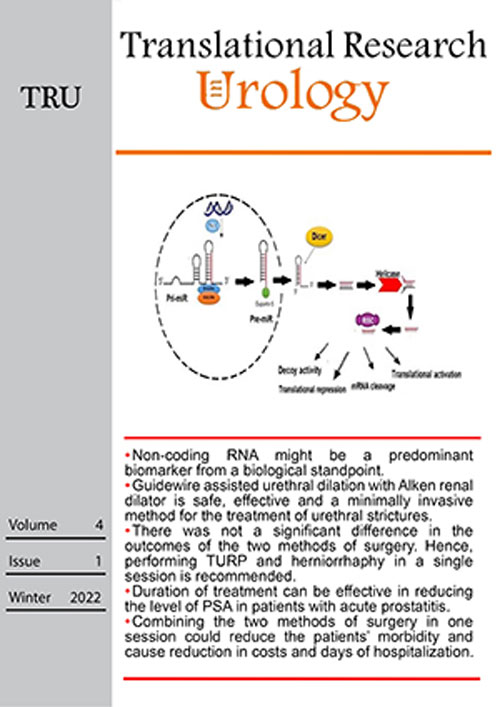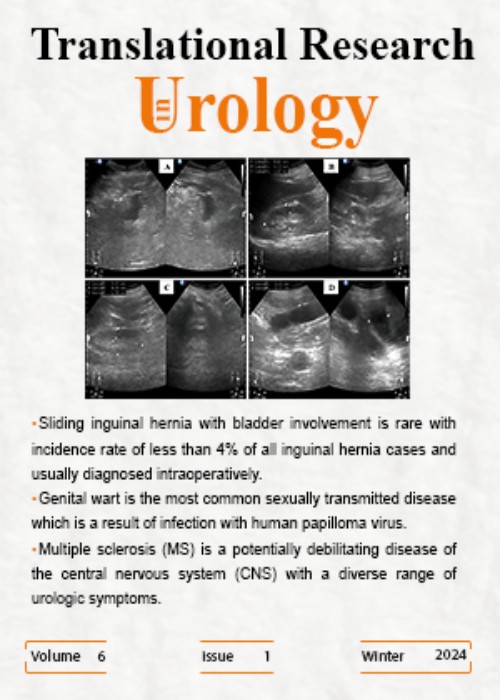فهرست مطالب

Journal of Translational Research in Urology
Volume:4 Issue: 1, Winter 2022
- تاریخ انتشار: 1400/12/16
- تعداد عناوین: 8
-
-
Pages 1-3
Almost all medicine practices, including diagnosis, treatment, and prognosis of different diseases, need human attention to be precisely performed. As the number of parameters for medical decision-making increases, medical practices become error-prone, time-consuming, and cumbersome, leading to the quality degradation of decision-making procedures. This situation gets severe when most patients need to be considered in routine medical practices. As a science and engineering discipline, Artificial intelligence offers a wide variety of techniques to analyze various medical data with high accuracy and speed. Furthermore, the output of AI systems assists physicians as a second opinion in diagnosing the disease, optimal planning of the treatment procedure, and precise prediction of treatment response. Similar to many sub-fields of medicine, using AI techniques in the practice of urology is becoming prevalent. Therefore, various complex urological disorders can be diagnosed and treated; thanks to AI techniques. Therefore, great attention should be paid to the role of artificial intelligence in urology.
Keywords: Machine Learning, Deep Learning, Computer-aided diagnosis, Computer-Aided Detection, Urology Practice -
Pages 4-8Introduction
Priapism is not a common condition among children. It is a medical emergency irrespective of the age at presentation and requires immediate management to avert long-term complications.
Case PresentationWe present a 9-year-old boy who presented with fever and cough of 2 days and a sustained painful erection of 5-hour duration and breathlessness just before presentation to a hospital. He eventually tested positive for severe acute respiratory syndrome coronavirus two infections (COVID-19). He did not have any predisposing condition such as sickle cell disease, leukaemia, or associated trauma to the pelvis or genitalia. He was also not on any implicating medication. He achieved detumescence on conservative management.
ConclusionAuthors conclude that it is more likely that the patient developed priapism due to COVID-19.
Keywords: Priapism, medical emergency, Respiratory Distress, SARs CoV 2 infection -
Pages 9-23Nowadays, non-communicable diseases are the leading cause of death worldwide. Cancer management has been a significant challenge for public health in the last decade. Aging of the population and Urbanization have induced significant alters in population structure and increased burden of non-communicable diseases, like cancers. For several years, cancer genomics studies traditionally focused on coding genes. An explosion of studies into non-coding RNAs biology has shown that they could function as tumor suppressors and oncogenic drivers in nearly all cancer types. As a result, the uncovering of the role of functional RNAs in the formation and development of cancers is a promising frontier of cancer genetics.Keywords: Non-coding RNA, ncRNA, lncRNA, miRNA, circRNA
-
Pages 24-29IntroductionGiven that studies on the association between pre/post-treatment PSA levels in acute prostatitis are limited and investigations in men from different communities are few, the present study aimed to determine the pre/post-treatment changes in the prostate-specific antigen (PSA) levels in patients with acute prostatitis.MethodThe current cross-sectional study was conducted in 2020 on a population of men with acute prostatitis. The patients were then referred to a laboratory to measure PSA levels for a definitive diagnosis of acute prostatitis. Prostate volume was determined using ultrasound. Afterward, drug treatment was started for the patient, followed by monitoring. The PSA levels were re-measured, and prostate volume was recorded after treatment. Patient information included patient profile, age, date of the first visit, PSA level at the baseline (before treatment), diagnosis of acute prostatitis, time to start treatment, time to end treatment, PSA level after treatment, and prostate volume.ResultsThe mean and standard deviation of the age of these patients was 59.90±6.31 years old. The results showed a significant relationship between age and primary PSA at the beginning of diagnosis and PSA reduction. (P-value<0.05). There is a significant relationship between age and duration of treatment (P-value=0.001). The duration of treatment was significantly related to the reduction of PSA, the amount of primary PSA at the beginning of diagnosis, and the amount of secondary PSA after treatment (P-value<0.05).ConclusionThe study's findings can be concluded that the duration of treatment can effectively reduce the level of PSA in patients with acute prostatitis. Extensive studies with a control group for future studies are recommended.Keywords: treatment, Prostate-Specific Antigen, Acute Prostatitis
-
Pages 30-34IntroductionThe present study aimed to evaluate the results of doing Transurethral Resection of the Prostate (TURP) and inguinal mesh herniorrhaphy in a single session versus doing them in two separate sessions.MethodsIn a randomized clinical trial from 2017 to 2020, 84 patients with inguinal hernia and BPH (benign prostatic hyperplasia) were selected and categorized randomly into two separated groups. TURP and mesh herniorrhaphy were done in a single operation in group I. In group II, into TURP was done at first, and then, three months later, in another admission, inguinal hernia repair was done.ResultsMean duration of operation was 63.04±6.8 minutes in group I and 77.2±8.5minutes in group II (p-value<0.01). The mean duration of hospitalization was 3.8±0.7days in group I and 5.88±1.01 days in group II(p-value<0.001). The average time of Foley catheterization was 4.7±0.73 days in group I and 4.3±0.64 days in group II(p-value<0.01). The mean rate of international prostate symptom score (IPSS) before and after the operation was 25.6±3.8 and 12.3±2.9 (p-value<0.01) in group I, and 26.6±2.6 and 12.7±2.1 in group II (p-value<0.01). There was no correlation between symptoms before the treatment and general satisfaction after the treatment, and there were no differences in other minor complications.ConclusionForasmuch as there are no significant differences in outcomes, TURP and mesh Herniorrhaphy in a single session versus doing them in two separated operations can be recommended. Although, because of the longer duration of catheterization in the patients who have done TURP and mesh Herniorrhaphy in a single session, it is needed to do some more investigations about post-operation catheterizing.Keywords: Transurethral Resection of Prostate, Herniorrhaphy, Hernioplasty, benign prostatic hyperplasia, Inguinal
-
Pages 35-40IntroductionThis research was conducted to assess whether prophylactic citrate potassium can reduce double-J stent encrustation in patients with urolithiasis.MethodsIn the present study, 70 patients with urolithiasis were randomly assigned to two groups of control [22 men; mean age 43 (33-55)] and intervention [25 men; mean age, 41 (37-56)] after meeting inclusion criteria. Potassium citrate (10 mEq Alithoral tablet) was administered three times a day from double-J stent insertion until removal in the intervention group. For the control group, no treatment was given. It was examined after removing the stent, and laboratory tests were performed in encrustation. Moreover, blood and urine were collected for assessing creatinine, crystalluria, and pyuria. Information concerning the duration of double-J stent placement, the composition of urinary stone (calcium oxalate or other), number of attack episodes, type of double-J stent (one way or other), and smoking habit were collected.ResultsThree control group participants were excluded from the study due to missing follow-up. Patients of the two groups were matched for age, sex, duration of the double-J stent placement, and the number of attack episodes. There were significant differences regarding crystalluria and creatinine dosage between the two groups. Furthermore, double-J stent encrustation occurred in 3 (8.8%) and 11 (34.4%) patients of the intervention and control group, respectively, which showed a significant difference (P-value=0.012). Comparison between intervention and control group revealed an odds ratio of 18% (P-value=0.017) and 15% (P-value=0.023) in the crude and adjusted model, respectively.ConclusionPotassium citrate can significantly reduce double-J stent encrustation in patients with urolithiasis. Therefore, it is recommended that urologists consider citrate potassium as a preventive treatment for encrustation.Keywords: Double-J, Potassium Citrate, Stent Encrustation, Transurethral Lithotripsy
-
Pages 41-46Introduction
The main purpose of this study was to investigate the relationship between Covid-2019 and sexual dysfunction.
MethodsA cross-sectional study included the affected coronavirus disease 2019 patients in outpatient and inpatient settings between July 2020 and December 2020. This study was used the International Index of Erectile Function (IIEF-5) and Female Sexual Function Index (FSFI) questionnaires to evaluate sexual function. Two different questionnaires were used for men(15 questions) and women (19 questions). Two similar forms were given to the affected patients; the first questionnaire related the sexual function status before the pandemic, and the second related to the sexual function changes after the Covid-2019 infection (at least one month after covid infection recovery).
ResultsThe sexual desire significantly decreased in males (change from 12.58±2.15 to 10.75 ±2.81; P-value<0.001) and females (change from 14.75±3.01 to 12.67±3.62; P-value<0.001 ) patients after the Covid-2019 infection compared to the pre-covid period, respectively. The sexual function also significantly decreased in affected patients by Covid-2019 infection in males (from 63.91±10.22 to 54.06±12.43; P-value<0.001) and females (from77.4±15.09 to 61.54±16.18; P-value<0.001) patients after the Covid-2019 infection compared to the pre-covid period, respectively. Also, the mean score of sexual desire was lower in men, which means the decrease in sexual desires was more severe in men than women. Patients with more severe disease and a history of ICU admission had a more severe decrease in sexual function scores compared to the outpatient setting.
ConclusionThe sexual desire and sexual function scores significantly decreased in affected patients by Covid-2019 infection compared to the pre-covid period in males and females. The mean score of sexual desire was lower in men affected with Covid-2019 infection compared to the females. Patients with more severe disease and a history of ICU admission had a more severe decrease in sexual function scores compared to the outpatient setting.
Keywords: Covid-2019 Infection, Sexual Desire, Sexual Function, Sexual Satisfaction -
Pages 47-53Introduction
The emergence of superbugs puts the world into an antibiotic-resistance era, and antimicrobial peptides could solve this severe problem. The aim of this study was the in vitro evaluation of the bactericidal effects of the Nisin on Staphylococcus aureus, probable cytotoxic effects, and its impact on host-microbe interactions.
MethodsThe minimal inhibitory concentration of Nisin was determined, and Nisin-induced cell toxicity was assessed by MTT assay. Then, the pro-inflammatory effects of Nisin on ACHN (kidney tumor cell line), and 5637 (bladder tumor cell line) cell lines were analyzed by ELISA (enzyme-linked immunoassay). Finally, the sensitivity of two biofilm-producing S. aureus to Nisin was evaluated in planktonic and biofilm-resident cells by crystal violet assay.
ResultsMIC for methicillin-sensitive S. aureus (MSSA) and methicillin-resistant S. aureus (MRSA) was 1μg/ml and 2μg/ml, respectively. A low concentration of Nisin demonstrated no cytotoxic effects on studied cell lines. However, high cytotoxicity was found at the following concentrations 330 and 430 μg/ml of Nisin compared to the negative control. Only a high dose of Nisin induced high levels of interleukin-6 (IL-6) in ACHN cells. In contrast, low concentrations of Nisin in 5637 cells induced the secretion of high levels of IL-6. In cell culture, Nisin inhibited the S.aureus-induced cytotoxicity and the release of IL-6 from kidney and bladder cell lines.
ConclusionsOur results demonstrated that Nisin, efficiently inhibiting MRSA and MSSA strains, antagonized bacteria-induced inflammatory responses in ACHN and 5637 cells. In summary, the bioactivities of Nisin make it a promising candidate as a further antimicrobial agent for targeting S. aureus infections.
Keywords: Antimicrobial Peptide, Biofilm, Inflammatory Responses, Nisin


